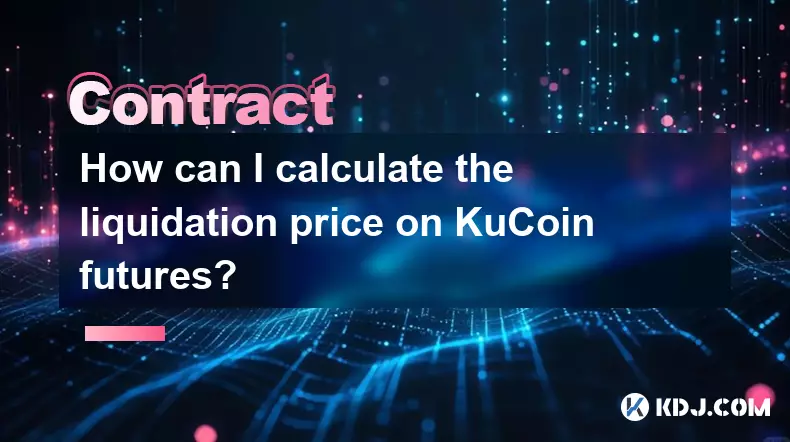-
 bitcoin
bitcoin $122090.672462 USD
1.59% -
 ethereum
ethereum $4493.758974 USD
0.56% -
 xrp
xrp $3.033145 USD
0.65% -
 tether
tether $1.000629 USD
0.00% -
 bnb
bnb $1169.854250 USD
7.07% -
 solana
solana $230.954786 USD
-0.19% -
 usd-coin
usd-coin $0.999785 USD
0.00% -
 dogecoin
dogecoin $0.256108 USD
-1.12% -
 tron
tron $0.342333 USD
-0.12% -
 cardano
cardano $0.859632 USD
-0.10% -
 hyperliquid
hyperliquid $48.932146 USD
-2.25% -
 chainlink
chainlink $22.345466 USD
-1.29% -
 ethena-usde
ethena-usde $1.000217 USD
-0.03% -
 avalanche
avalanche $31.203456 USD
1.93% -
 sui
sui $3.579145 USD
1.05%
How can I calculate the liquidation price on KuCoin futures?
KuCoin's liquidation price is the point at which a leveraged position closes automatically to prevent further losses, calculated using entry price, leverage, and maintenance margin.
Sep 21, 2025 at 11:37 pm

Understanding Liquidation Price in KuCoin Futures
1. The liquidation price on KuCoin futures represents the market price at which a trader’s position is automatically closed due to insufficient margin. This mechanism protects both traders and the exchange from excessive losses. When the mark price of an asset reaches this threshold, the system triggers a liquidation event.
2. Each futures contract has its own liquidation engine that continuously monitors the account balance, leverage level, and current position size. If the equity in a position drops below the maintenance margin required by KuCoin, the system initiates liquidation procedures. This process prevents negative balances and maintains platform stability.
3. Traders can view their estimated liquidation price directly within the KuCoin trading interface. It appears alongside key metrics such as entry price, unrealized PNL, and leverage settings. Understanding how this value is derived helps users manage risk more effectively during volatile market conditions.
4. The calculation differs slightly between long and short positions. For longs, liquidation occurs when the price falls to a critical point; for shorts, it happens when the price rises beyond a certain level. These thresholds depend on funding rates, fees, and the chosen leverage ratio applied to the initial margin.
Key Factors Influencing Liquidation Price
1. Leverage plays a central role in determining the liquidation price. Higher leverage reduces the buffer between entry price and liquidation point, making positions more vulnerable to sudden price swings. A 10x leveraged trade will have a much closer liquidation price than a 2x position with the same entry.
2. Position size affects the maintenance margin requirement. Larger positions demand higher collateral reserves, altering the liquidation dynamics. As the notional value increases, even small adverse movements can trigger early liquidation if margins are thin.
3. Funding payments impact the effective cost basis over time. While not directly part of the core formula, ongoing funding deductions or additions influence the available margin balance. Frequent negative funding can erode equity faster, pushing the liquidation price closer to the current market rate.
4. Market volatility indirectly shapes liquidation risks. During high-volatility periods, price slippage may cause actual execution prices to deviate from theoretical levels. KuCoin uses mark price rather than last traded price to prevent manipulation-based liquidations, adding another layer of complexity.
Manual Calculation Method for Liquidation Price
1. For isolated margin mode, the basic formula for a long position is: Liquidation Price = Entry Price × (1 − Initial Margin Rate + Maintenance Margin Rate). The initial margin rate equals 1 divided by leverage (e.g., 0.05 for 20x), while the maintenance margin rate is set by KuCoin based on contract tier.
2. For a short position, the formula adjusts to: Liquidation Price = Entry Price × (1 + Initial Margin Rate − Maintenance Margin Rate). This reflects the inverse relationship where rising prices threaten short trades. Both formulas assume no additional fees or funding impacts.
3. Cross-margin mode calculations are less transparent because shared equity across positions makes precise modeling difficult. However, the principle remains the same—when total account equity falls below the sum of all maintenance margins, partial or full liquidation begins.
4. Users must refer to KuCoin’s official documentation for exact maintenance margin percentages per contract type and tier. These values vary depending on whether the instrument is linear or inverse, and they scale non-linearly with increasing position size.
Frequently Asked Questions
What is the difference between mark price and last price in liquidation?Mark price is used to determine liquidation events to avoid unfair closures due to temporary price spikes or flash crashes. It is typically derived from a spot index plus a fair premium/discount. Last price reflects recent trades but can be manipulated, so relying on it alone would increase vulnerability.
Can I avoid liquidation by adding more margin?Yes, in isolated margin mode, users can increase their margin manually before reaching the liquidation threshold. This action raises the buffer between current price and liquidation level. However, this feature is unavailable in cross-margin mode where funds are pooled automatically.
Does KuCoin provide warnings before liquidation?KuCoin displays real-time risk indicators and sends alerts when positions approach dangerous levels. The health ratio bar turns red as the liquidation price nears the mark price. Traders should monitor these signals closely, especially during low-liquidity periods.
Disclaimer:info@kdj.com
The information provided is not trading advice. kdj.com does not assume any responsibility for any investments made based on the information provided in this article. Cryptocurrencies are highly volatile and it is highly recommended that you invest with caution after thorough research!
If you believe that the content used on this website infringes your copyright, please contact us immediately (info@kdj.com) and we will delete it promptly.
- BlockDAG, DOGE, HYPE Sponsorship: Crypto Trends Shaping 2025
- 2025-10-01 00:25:13
- Deutsche Börse and Circle: A StableCoin Adoption Powerhouse in Europe
- 2025-10-01 00:25:13
- BlockDAG's Presale Buzz: Is It the Crypto to Watch in October 2025?
- 2025-10-01 00:30:13
- Bitcoin, Crypto, and IQ: When Genius Meets Digital Gold?
- 2025-10-01 00:30:13
- Stablecoins, American Innovation, and Wallet Tokens: The Next Frontier
- 2025-10-01 00:35:12
- NBU, Coins, and Crypto in Ukraine: A New Yorker's Take
- 2025-10-01 00:45:14
Related knowledge

What is the difference between futures and perpetual contracts for Bitcoin?
Oct 02,2025 at 11:54pm
Understanding Bitcoin Futures Contracts1. Bitcoin futures are derivative instruments that allow traders to speculate on the future price of Bitcoin at...

What is the best time to trade PEPE contracts?
Oct 03,2025 at 11:54am
Understanding PEPE Contract Volatility1. PEPE contracts exhibit extreme price fluctuations due to their meme-based nature and low market cap. Trading ...

What are the common mistakes to avoid with Bitcoincoin contracts?
Oct 03,2025 at 08:54am
Emerging Trends in the Cryptocurrency Market1. Decentralized finance (DeFi) platforms continue to expand their influence across the blockchain ecosyst...

What is the maintenance margin for Bitcoin contracts?
Oct 02,2025 at 01:36am
Decentralized Exchanges Gain Momentum in 20241. Decentralized exchanges (DEXs) have seen a significant rise in trading volume, surpassing centralized ...

How to use technical analysis for trading XRP contracts?
Oct 03,2025 at 01:18pm
Understanding Price Patterns in XRP Futures1. Identifying chart patterns such as triangles, head and shoulders, and double tops or bottoms can provide...

What does "longing" PEPE contracts mean?
Oct 03,2025 at 11:54pm
Understanding Decentralized Exchanges in the Crypto Ecosystem1. Decentralized exchanges (DEXs) operate without a central authority, allowing users to ...

What is the difference between futures and perpetual contracts for Bitcoin?
Oct 02,2025 at 11:54pm
Understanding Bitcoin Futures Contracts1. Bitcoin futures are derivative instruments that allow traders to speculate on the future price of Bitcoin at...

What is the best time to trade PEPE contracts?
Oct 03,2025 at 11:54am
Understanding PEPE Contract Volatility1. PEPE contracts exhibit extreme price fluctuations due to their meme-based nature and low market cap. Trading ...

What are the common mistakes to avoid with Bitcoincoin contracts?
Oct 03,2025 at 08:54am
Emerging Trends in the Cryptocurrency Market1. Decentralized finance (DeFi) platforms continue to expand their influence across the blockchain ecosyst...

What is the maintenance margin for Bitcoin contracts?
Oct 02,2025 at 01:36am
Decentralized Exchanges Gain Momentum in 20241. Decentralized exchanges (DEXs) have seen a significant rise in trading volume, surpassing centralized ...

How to use technical analysis for trading XRP contracts?
Oct 03,2025 at 01:18pm
Understanding Price Patterns in XRP Futures1. Identifying chart patterns such as triangles, head and shoulders, and double tops or bottoms can provide...

What does "longing" PEPE contracts mean?
Oct 03,2025 at 11:54pm
Understanding Decentralized Exchanges in the Crypto Ecosystem1. Decentralized exchanges (DEXs) operate without a central authority, allowing users to ...
See all articles










































































